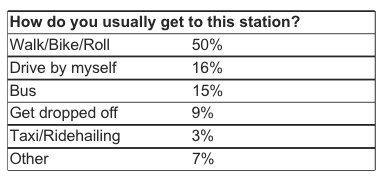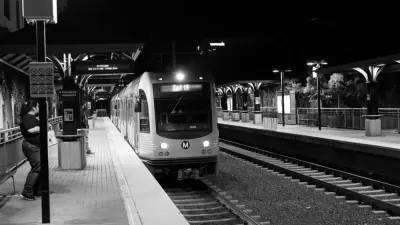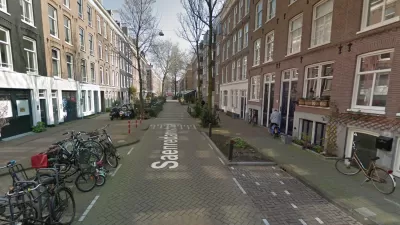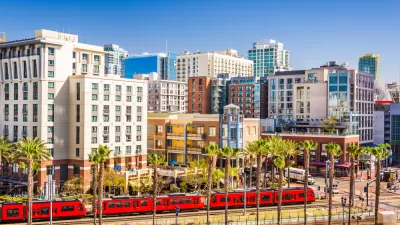The light rail extension opened May 20 and is already 70 percent toward meeting its 2030 ridership projection. According to a survey conducted in June by Metro, more than two-thirds of riders were new to the Expo Line.

As posted in June, ridership is soaring on Metro's two new light rail line extensions on the Gold and Expo lines. A survey of 1,000 riders that Metro conducted in June on Expo Phase 2, i.e., the new, 6.6-mile, seven-station extension from Culver City Station to Downtown Santa Monica Station, was posted in Metro's transit blog, The Source, on Sept. 12.
Phase 2 includes new stations at:
- Palms
- Westwood/Rancho Park
- Expo/Sepulveda
- Expo/Bundy
- 26th St./Bergamot
- 17th St./SMC
- Downtown Santa Monica
Metro found 70 percent of riders between Culver City and Santa Monica "were new to the Expo Line," reports Meghan McCarty who covers commuting and mobility issues for KPCC, Southern California Public Radio. "Of the new riders, nearly half used to drive alone while 23 percent had switched from bus service."
Light rail cars needed, not more parking spaces for motor vehicles
All that early talk about insufficient parking at stations that caused neighbors to fear an inundation of commuters parking on residential streets proved to be unfounded, at least for now. Judging from how new riders are accessing the stations, according to the survey, crowded sidewalks and bike lanes may be more of a concern.

Credit: Metro via The Source
However, "[r]iders who access the Expo Line by driving alone to stations do so at a higher rate, 16 percent, compared to Metro riders as a whole at 5 percent," adds McCarty, though they "have not overwhelmed the three new parking lots along the line. Metro reported in July the new lots are only 30 to 50 percent full on most days."
What's plaguing Metro is not a shortage of parking spots but a shortage of cars, light rail cars, that is, on the Expo Line, "due to manufacturing delays," reports McCarty.
But officials have promised that enough new cars will be in service by December to allow trains to run every six minutes during peak hours. They now run about every 12 minutes or more.
"Seasoned riders and transit newcomers have griped about cars so jammed during peak hours that there is no room for bicycles, wheelchairs or, at some stations, any more passengers," reported Laura J. Nelson for the Los Angeles Times. Nelson explains what went wrong, with Metro first ordering rail cars from AnsaldoBreda, an Italian firm, then Osaka-based Kinkisharyo International, to be manufactured in Palmdale.
Hat tip to Mike Bullock.
FULL STORY: Metro says Expo Line to Santa Monica converted solo drivers to transit users

Study: Maui’s Plan to Convert Vacation Rentals to Long-Term Housing Could Cause Nearly $1 Billion Economic Loss
The plan would reduce visitor accommodation by 25,% resulting in 1,900 jobs lost.

North Texas Transit Leaders Tout Benefits of TOD for Growing Region
At a summit focused on transit-oriented development, policymakers discussed how North Texas’ expanded light rail system can serve as a tool for economic growth.

Why Should We Subsidize Public Transportation?
Many public transit agencies face financial stress due to rising costs, declining fare revenue, and declining subsidies. Transit advocates must provide a strong business case for increasing public transit funding.

How Community Science Connects People, Parks, and Biodiversity
Community science engages people of all backgrounds in documenting local biodiversity, strengthening connections to nature, and contributing to global efforts like the City Nature Challenge to build a more inclusive and resilient future.

Alabama: Trump Terminates Settlements for Black Communities Harmed By Raw Sewage
Trump deemed the landmark civil rights agreement “illegal DEI and environmental justice policy.”

Dear Tesla Driver: “It’s not You, It’s Him.”
Amidst a booming bumper sticker industry, one writer offers solace to those asking, “Does this car make me look fascist?”
Urban Design for Planners 1: Software Tools
This six-course series explores essential urban design concepts using open source software and equips planners with the tools they need to participate fully in the urban design process.
Planning for Universal Design
Learn the tools for implementing Universal Design in planning regulations.
City of Santa Clarita
Ascent Environmental
Institute for Housing and Urban Development Studies (IHS)
City of Grandview
Harvard GSD Executive Education
Toledo-Lucas County Plan Commissions
Salt Lake City
NYU Wagner Graduate School of Public Service





























